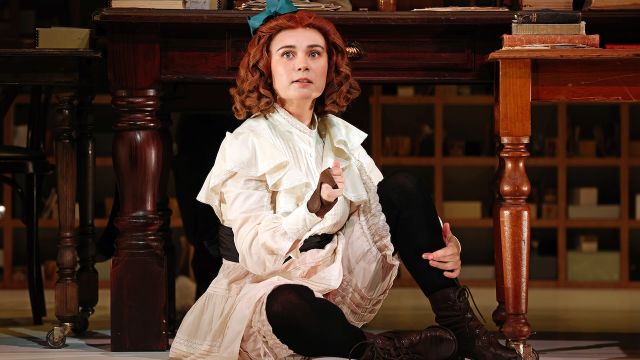The Dictionary of Lost Words
The book The Dictionary of Lost Words, written by Australian author Pip Williams was first published in 2020. It quickly became a bestseller in Australia and was the first Australian novel to be selected for Reese Witherspoon’s Book Club. The book was adapted to a play by Verity Laughton and first brought to the stage in 2023.
Opening night of The Dictionary of Lost Words was approached with some trepidation by this reviewer. The first iterations of the play were met with much comment about it being bogged down in exposition and detail. In trying to include so many aspects of the book, some reviewers posed that it had said little.
I am delighted to say that this current version, directed by Jessica Arthur is wonderful. Her casting is spot on and her leading lady Shannen Alyce Quan lifts the potentially dialogue-heavy show to a new level. Her joyful and mesmerising portrayal of Esme Nicoll is powerful and this young actor shows great skill in navigating the wide age range and the multitude of emotions needed.

Esme’s first moments on stage are as a wide eyed four year old resplendent in red curls hovering beneath the table. This is the Scriptorium (or Scrippy) at Oxford in 1886 where the real Sir James Murray, lead editor of the Oxford English Dictionary and a group of other men are enthusiastically sorting through words to decide upon those deemed suitable to be included in the dictionary.
The metaphor of Esme being ‘beneath the table’ gathering the scraps of paper with discarded words not fit for the actual dictionary by the men, is poetic. The plight of women in Victorian England as lesser, unseen, unimportant, is immediately put in focus and is a recurrent theme in the play.
As we follow Esme’s coming of age story she collects her own words –vulgar words, women’s words, slang words- all of which are deemed by the men and society in general, not to be important or valuable enough to be included in the Oxford Dictionary. This collection is preciously kept in a trunk labelled by Esme as “The Dictionary of Lost Words”.

Esme’s life curves in and out from her childhood into adulthood, through historical times- the women’s suffrage movement, the start of the First World War. There are some powerful moments in this play, highlighting women as the ‘lost’ ones- having to fight to be seen and heard and through war, abandoned.
Esme’s unwanted pregnancy also highlights the difficulty for women of the time- particularly those that actually wanted to carve out a life for themselves. Esme’s newborn is shipped off to live with a family in South Australia. This serendipitously runs full circle at the end of the play- a delightful conclusion and one, which coupled with some earlier dialogue on women’s suffrage, highlights the progressiveness of our own little state on the world stage.
Harry Nicoll, Esme’s father is intuitively played by Johnny Nasser as he battles to love and guide his motherless daughter and at the same time contribute to one of the world’s great achievements. His one-on-one interactions with Esme are beautiful.

Kathryn Adams is to be congratulated for her varied roles- she plays three very different characters- the loving young “bondmaid” Lizzie, Mrs Smythe and suffragist Maria with aplomb and perfect accents.
Brian Meegan brings humour and joy to a character that could have been very dull as Sir James Murray and Arkia Ashraf as Gareth is poignant and moving, carrying his station with poise.
For this reviewer, a highlight in the ensemble, was the work of Ksenja Logos who plays multiple roles - from the very straight, but maternal Ditte to the uproariously funny and foul- mouthed Mabel. Wonderful.

Angela Nica Sullen is to be congratulated for her various characters- particularly switching from the subdued Arthur Maling in the scriptorium to the outrageously strong Tilda Taylor, actress and suffragette. Great character work.
As Bill Taylor, the father of Esme’s child and Frederick Sweatman, James Smith again shows his versatility and stage experience and smoothly moves in and out of character with ease.

The set for The Dictionary of Lost Words is designed by Jonathon Oxlade and is a star in itself. Figuratively showcasing how life is pigeonholed and categorised into types and ‘what belongs’, the beautifully lit (Trent Suidgest) cubicles overlooked by a half wall cyclorama are clever and a focal point. Centre stage are the sorting tables under which Esme spends much of her childhood. Whilst the cubicles hold the words of the Scrippy, it is also a repository for all other props- teapots, letters and the like. The set cleverly has included doors and a staircase where a high mezzanine is utilised well by director, Jessica Arthur.
It is the wonderful use of projection onto the cyclorama which really sets this play apart- times and locations are show in very eclectic ways, transforming the stage to a covered market, a kitchen, a school and a bedroom. Particularly moving was the war scene- extremely creative.
Director Arthur is very clear and guides us swiftly from scene to scene. This is a tightly choreographed show which captivates through insightful acting and juxtaposed use of multimedia against a less technical time. Lighting changes and the use of music are subtle, evoking scene emotions well. Costuming by Ailsa Paterson is clever and perfect for the era.

This is a wonderfully thought-provoking night of theatre. This ensemble are tight and well directed, and the staging is creative using the space to great effect.
Well worth attending!
Shelley Hampton
Photographer: Prudence Upton
Subscribe to our E-Newsletter, buy our latest print edition or find a Performing Arts book at Book Nook.

